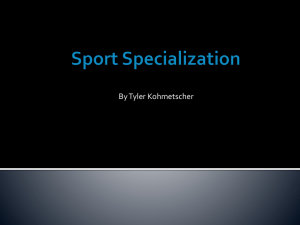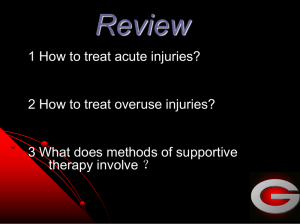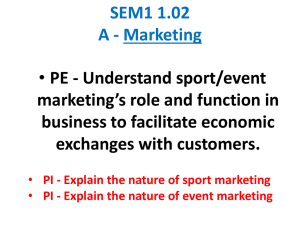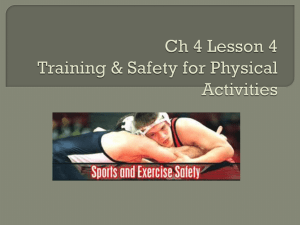KH 2130 Issues presentation
advertisement
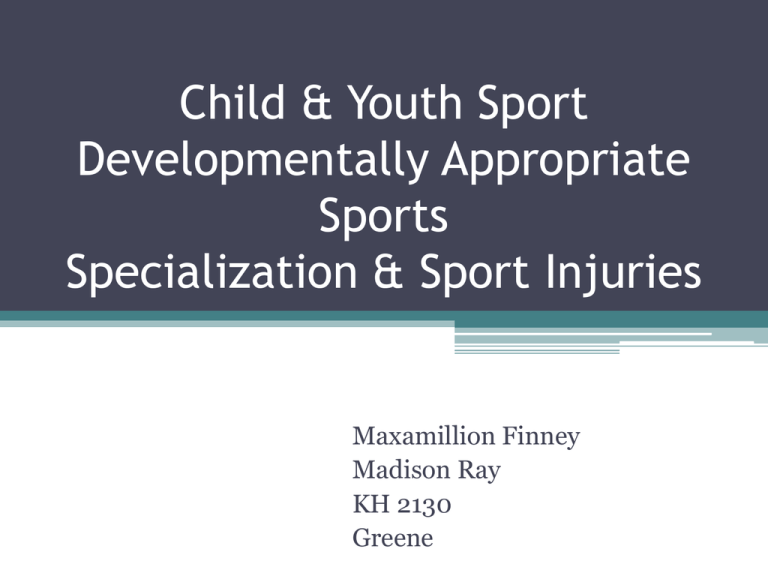
Child & Youth Sport Developmentally Appropriate Sports Specialization & Sport Injuries Maxamillion Finney Madison Ray KH 2130 Greene Age Appropriate Sports For Children • Ages 5-6 Children develop the capacity to compare themselves to others in order to understand their own competence. • At the age of 7 one should start using competition as motivation • Then at age 8 the child starts to participate in more organized and competitive sports. Children’s Bill of Rights • • • • • • • • • • Children should have the right: To participate regardless of ability To participate at a level commensurate with their ability level To have qualified adult leadership To participate in safe and healthy environments To share in Leadership and decision making To play as a child and not as an adult To receive proper preparation for participation To have equal opportunity to strive for success To be trained with dignity To have fun How Games Should Go • All sport games for children should be modified to fit the developmental status of the participants • If a child and youth sport is defined primarily as a performance ethic rather than “fun” ethic, many of the positives outcomes described may not be achieved. Types of Developmental Benefits Psychological/Emotional: Sport and physical activity offer youth opportunities to experience challenge, fun, and enjoyment, while increasing their self-esteem and decreasing their stress (Csikszentmihalyi, 1975; Long, 1985; Health Canada, 2003). Types of Development Cont. Physical: While cardiovascular fitness and weight control are among the most evident healthbenefits of physical activity (Health Canada, 2003; Taylor et al., 1985), skill development, improved muscular strength, muscular endurance, flexibility, and bone structure are additional benefits (Wankel & Berger, 1990; Coˆte´ & Hay, 2002). Types of Development Cont. Social: Youth have opportunities to experience positive intergroup relations, community integration, social status, and social mobility, while Coˆte´ (2002) suggests that sport provides an arena for the development of social skills such as cooperation, assertion, responsibility, empathy, and self-control. Types of Development Cont. Intellectual: • Participation in school sport has been positively linked to school grades, school attendance, choice for demanding courses, time spent on homework, educational aspirations during and after high school, and college attendance (Snyder & Spreitzer, 1990; Marsh, 1993; Eccles & Barber, 1999; Whitley, 1999). Specialization: A few Facts • Children and youth did not specialize in a sport until the college level. • Even on the college level it was hard to find a two-sport athlete. • In high schools, boys played on a team in 2/3 of the sport season. • Girls didn’t have this opportunity. ▫ If they did they would also be playing multiple sports Sport Specialist • Now in high school we see the 3 sport athlete. ▫ They train year-round for his/her sport, competes on the school team and again on a club team during the off-season. • To this day we see that a sub-level of sportspecialization is becoming more and more common ▫ This is the Early Specialist Early Specialist • Athletes such as gymnasts and swimmers train at an early age year-round for their sport • Hockey and soccer players get their early training in sport-specialization clubs. *****There is without a doubt that advances in Exercise Science have made year-round strength and endurance training apart of specialization. Extra Information • Not only do young athletes specialize in a single sport, but in some cases they will specialize in a single position within that sport. • The more talented the young athlete, the more pressure to train year-round and specialize will be put on. ▫ Some pressure comes from parents and others who see a college scholarship and eventually and professional career ahead for the athlete. Is Specialization Appropriate? • For those who survive, there’s no doubt that it is successful in developing talented elite athletes. • Less is known for those who burn out or suffer overuse injuries that get them off track. Is Specialization Appropriate? Cont. • According to The National Association for Sport and Physical Education “year-round specialization in a single sport for boys or girls under the age of 15 is more often associated with developmental risks rather than rewards.” • Medicalnewstoday.com talks about sport specialization at an early age may be detrimental to performance at a larger age rather than lead to future athletic success. Is Specialization Appropriate? Cont. • “Participating in a variety of sports will help a child develop other athletic skills that they would not develop if they specialized in one sport too early,” says Jennifer VanSickle of U of Indianapolis. • Certain athletic skills that are stressed differently in every sport: ▫ Speed, balance, mental focus, jumping and reacting. • Those athletic skills will transfer to the individual child’s primary activity to everything a child does to become a better all-around athlete. Sports Injuries (Children & Youth) • Data on the degree and nature of injuries in child or youth sport is difficult to obtain. ▫ Whereas data on injuries in interscholastic sport are readily available. • Acute injuries are referred to as “macrotrauma” ▫ Sprains of joint ligaments, strains of muscle tendon units, contusions involving muscle tendon units and overlaying soft tissue, fractures of long bones and axial skeleton. • These injuries have been estimated to result in 4 million emergency-room visits per year. Sports Injuries resulting in hospital visits • Children for the ages 5-14 account for nearly 40% of all sports related injuries treated in hospitals each year. ▫ Including 175,000 visits to the hospital emergency rooms for treatment for concussions. • Because there are so many of these injuries, some hospitals open pediatric sport-medicine clinics. Extra Information • The more serious injuries are the overuse injuries that sometimes develop when children or youths specialize in a sport. • Since the softness of their bones and the relative tightness of their ligaments and tendons during growth spurts younger children have more overuse injuries. • What is known as “Little League elbow” is the result of damage to the growth cartilage of the elbow joint. ▫ Other common overuse injuries occur in the knee and ankle. Injuries Due to Extreme Sports • Current generation has seen growing involvement of children and youths in all kinds of extreme or action sports such as skateboarding, BMX biking, and in-line skating. • Activities that are inherently risky but that is the attraction. • Very little data exists on the nature or severity of injuries in these activities. Injuries Due to Extreme Sports Cont. • Some injuries like handlebar injuries in BMX stunt-biking, are so serious that some government health units are beginning to release warnings to media to alert parents of the potential dangers. • Handlebar injuries can result in ruptures of the spleen, liver, kidney, and bowel, sometimes so severely that organs need to be removed. Sado-Asceticism • Duquin suggests that what she called “sadoasceticism” has too frequently crept into child and youth sport. • Too many adults, coaches, and parents, support a “no pain, no gain” ethic for practice, training, and competition. • Duquin argues that the wisdom of the body and the wisdom of the childhood are to avoid pain, which “no pain is sane,” and typically children quit when they get hurt. Sado-Asceticism Cont. • The asceticism she describes as having crept into organized child and youth sport in recent years is to redefine pain as discomfort and to encourage young athletes to work through the discomfort. • “Adults may choose to sacrifice their bodies for the perceptions of truth. In youth sport, the ‘truths’ are those of adults, the sacrificial bodies are those of children” (Duquin, 1988, p.35)

